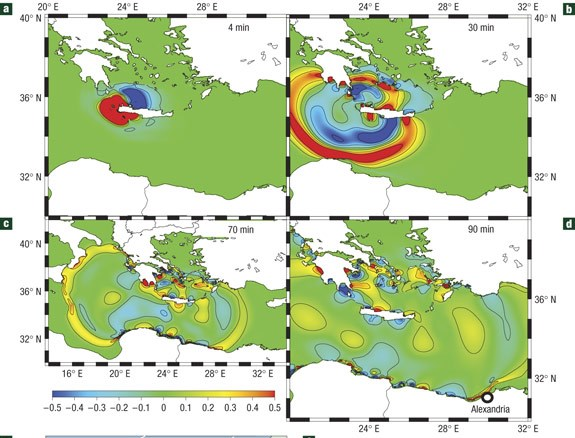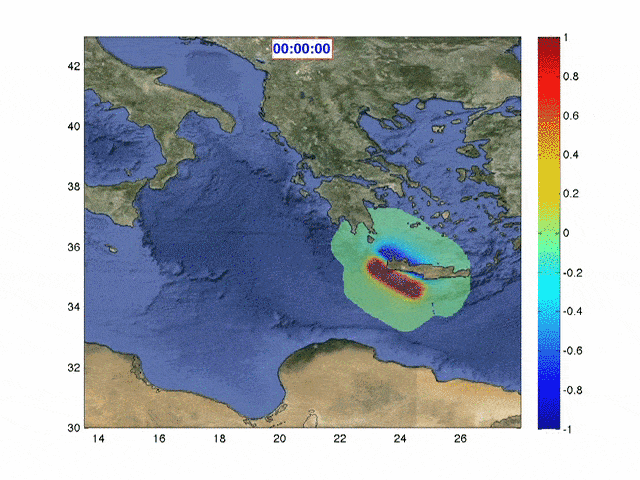 The tsunami generated by the AD 365 earthquake offshore Crete (GR), modeling estimates tsunami arrival times at the coasts (from 4 min in the upper left to 90 min in the lower right). The chromatic scale indicates the estimated height reached by the tsunami.
The tsunami generated by the AD 365 earthquake offshore Crete (GR), modeling estimates tsunami arrival times at the coasts (from 4 min in the upper left to 90 min in the lower right). The chromatic scale indicates the estimated height reached by the tsunami. The animation shows the numerical simulation of tsunami propagation generated by the Crete earthquake of AD 365. The timer above shows the estimated wave propagation time. The tsunami would take about 1 hour from its origin to reach the Italian coasts (800 km as the crow flies between Crete and Syracuse).
The animation shows the numerical simulation of tsunami propagation generated by the Crete earthquake of AD 365. The timer above shows the estimated wave propagation time. The tsunami would take about 1 hour from its origin to reach the Italian coasts (800 km as the crow flies between Crete and Syracuse).“Paulo enim post lucis exortum densitate praevia fulgorum acrius vibratorum tremefacta concutitur omnis terreni stabilitas ponderis mareque dispulsum retro fluctibus evolutis abscessit […] Ingentes aliae naves extrusae rabidis flatibus culminibus insidere tectorum, ut Alexandriae contigit, et ad secundum lapidem fere procul a litore contortae sunt aliquae.[...]
Here are some lines from the Res Gestae Latin opera composed by Ammiano Marcellino between 353 and 378 AD.
Using a refined style, sometimes not easy to interpret, the author accurately describes one of the largest and most destructive natural events that affected the ancient times and probably one of the strongest earthquakes ever occurred in the Mediterranean Sea.
It is July 21, 365 AD and, shortly before sunrise, an earthquake with estimated magnitude between 8 and 8.5 hits the eastern area of the Mediterranean Sea. Recent studies (Pararas-Carayannis, 2011; Kelly, 2004) proposed that the epicenter of the earthquake was near the Greek island of Crete, along the Hellenic Arc.
The earthquake generated a large tsunami. For an idea about the phenomenon it is appropriate to refer to the poetical license used by Monachos, the Greek poet, to describe the event: a "cosmic earthquake". In his writings he reports some specific figures - how surreal! -
- 50,000 people drowned by the tsunami (and not killed by the earthquake)
- Ships driven by the sea force, inland, for about 32 kilometers in the plain and for 11 kilometers in the hills (Ambraseys, 2009).
Peloponnese, Boeotia, Sicily and Dalmatia were affected.
Egyptian writers describe the tsunami in Alexandria where the sea crossed the boundaries and flooded the land for several kilometers. The water withdrawal left a large amount of sand on crops ruined by salt and the impetus of the waters. The same occurred in the lagoon of al-Manzala, in Egypt, between Damietta and Port Said villages where the land, previously rich in vegetation, became a desert..
An Italian study conducted by Polonia et al. (2013) empirically confirms the above historical texts. Based on geophysical surveys and core drilling in the Ionian Sea, the research team analyzed sediments 20-25 meters thick characterized by a rock called megaturbidite. The presence of this sediment corroborates the thesis that in those years (around 365 AD) there was a tsunami described by the authors of the time. The authors of the study compare this scenario to the recent tsunamis of Sumatra 2004 and Tohoku 2011.
References:
Ambraseys, N., (2009). Earthquakes in the Mediterranean and Middle East, A Multidisciplinary Study of Seismicity up to 1900. Cambridge University Press, 947 p.
Kelly, G. (2004). Ammianus and the Great Tsunami. The Journal of Roman Studies, 94, 141-167. doi:10.2307/4135013
Pararas-Carayannis, G., (2011). The earthquake and Tsunami of July 21, 365 AD in the Eastern Mediterranean Sea - Review of impact on the ancient world - Assessment of recurrence and future impact, the International Journal of the Tsunami Society, Honolulu, Hawaii, USA, vol. 30, no. 4, p. 253-292.
Polonia, A., Bonatti, E., Camerlenghi, A. et al. Mediterranean megaturbidite triggered by the AD 365 Crete earthquake and tsunami. Sci Rep 3, 1285 (2013). https://doi.org/10.1038/srep01285


